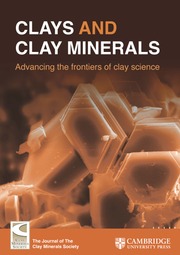Article contents
Adsorption of Ethylenediamine (EDA) on Montmorillonite Saturated with Different Cations—V. Ammonium- and Triethylammonium-Montmorillonite Ion-Exchange, Protonation and Hydrogen-Bonding
Published online by Cambridge University Press: 01 July 2024
Abstract
On NH4- as well as on (C2H5)3NH-montmorillonite EDA was adsorbed in protonated form. The extent of protonation depended on the relative basicities and concentrations of the interacting compounds. In the systems exposed to EDA vapor a proton transfer process took place. A similar mechanism, involving probably a water molecule which remained associated with the EDAH+ ion, occurred on air-drying (C2H5)3NH-montmorillonite treated with aqueous EDA, whereas no adsorption was observed when the suspension was washed. On the contrary EDA added, in quantities not exceeding the CEC, to a suspension of NH4-montmorillonite was adsorbed almost exclusively as EDAH22+ ion. This is explained in terms of ion-exchange between NH4+ and EDAH+ present in aqueous medium and protonation of the second amine function through the dissociation of water molecules near the clay surface.
Hydrogen-bonding between protonated and neutral EDA was observed when the extent of adsorption was higher than the extent of protonation.
Information
- Type
- Research Article
- Information
- Copyright
- Copyright © 1975, The Clay Minerals Society
References
- 7
- Cited by

